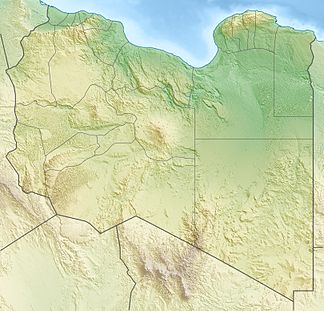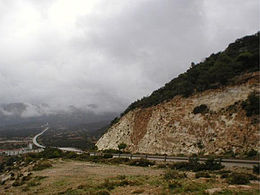al-Jabal al-Achdar (Libya)
| al-Jabal al-Achdar | ||
|---|---|---|
| location | Libya | |
| part of | North africa | |
|
|
||
| Coordinates | 32 ° 36 ′ N , 21 ° 28 ′ E | |
| rock | lime | |
Al-Jabal al-Achdar ( Arabic الجبل الأخضر, DMG al-Ǧabal al-Aḫḍar , other transcriptions: Jebel Akhdar , Jabal Akhdar and Djebel Akhdar ; German for Green Mountain ; after the ancient barque also obsolete Plateau von Barka ) is a mountain range in the historical region of Kyrenaika on the Libyan Mediterranean coast.
location
The highlands are located in the district of the same name al-Jabal al-Achdar and the neighboring municipalities of al-Hizam al-Achdar , al-Marj and al-Quba . The city of al-Baida is one of the largest cities in the region. The plateau stretches in a wide arc from the city of Benghazi for almost 300 km further over Derna to the east to over Umm ar Rizam .
geomorphology
The mean heights of the mountain plateau are around 400–600 meters, the highest point is around 880 meters. The north side is rocky and rugged, criss-crossed by many wadis and covered with red earth , it slopes relatively steeply to the Mediterranean, from which it is only separated by a narrow strip of coastal lowlands. The south side, on the other hand, gently descends in steps into the Libyan desert , the surface in many places consists of gray sand.
Flora and fauna
The location of the mountains on the Mediterranean Sea leads to relatively high, but strongly fluctuating amounts of precipitation of 250 to 600 mm per year and thus to a Mediterranean climate. Contrary to the other arid conditions in Libya, which is one of the most forested countries in the world, there are forest areas in this area on the order of about 3200 km², although about a third of the originally existing forest has already given way to agriculture. In addition to the forest, maquis and steppe-like areas dominate the picture. Typical plants of the maquis are the Phoenician juniper ( Juniperus phoenicea ), the mastic bush ( Pistacia lentiscus ), the Kermes oak ( Quercus coccifera ) and the carob tree ( Ceratonia siliqua ). In the drier steppe-like areas, the branchy affodil ( Asphodelus ramosus ), the thorny beaver nelle ( Sarcopoterium spinosum ) and the mugwort species Artemisia herba-alba dominate .
More than half of Libya's endemic plant species have their place of growth here. An example of this is the strawberry tree Arbutus pavarii .
history
The area was inhabited by Berber tribes , the Libyans , in antiquity , before the Greeks founded their colonies here. The ancient Greek colony of Cyrene was located in a fertile valley in the center of the plateau and was destroyed by an earthquake in 365.
In 643, as part of the Islamic expansion, Arab Muslims conquered Libya, followed by the Banu Hilal in the 11th century , before the region fell under Ottoman rule in 1517 .
From 1911 until the end of the Second World War, Libya was occupied by Italy, during which time thousands of Italian colonialists settled in the highlands of Jabal al-Achdar because it met the climatic needs of the Europeans. Even today, many farmhouses date from the time of the Italian occupation.
The Libyan Koran scholar and resistance fighter Umar al-Muchtar used the forested highlands as a retreat during the Italian occupation for more than 20 years.
photos
literature
- Martijn Theodoor Houtsma: First Encyclopaedia of Islam 1913-1936 . Barka. EJ Brill, Leiden 1993 ( limited preview in Google Book Search [accessed May 25, 2016]).
Web links
Individual evidence
- ↑ Barka . In: Meyers . 6th edition. Volume 2, p. 383 .
- ↑ a b c S.M. El-Darier, FM El-Mogaspi: Ethnobotany and Relative Importance of Some Endemic Plant Species at El-Jabal El-Akhdar Region (Libya) . In: World Journal of Agricultural Sciences . tape 5 , no. 3 , 2009, ISSN 1817-3047 , p. 353-360 ( online, PDF [accessed December 4, 2010]).
- ^ A b c Martijn Theodoor Houtsma: First Encyclopaedia of Islam 1913–1936 . Barka. EJ Brill, Leiden 1993.
- ^ Geoffrey Leslie Simons: Libya: The struggle for survival . 1993 ( limited preview in Google Book Search [accessed December 5, 2010]).




